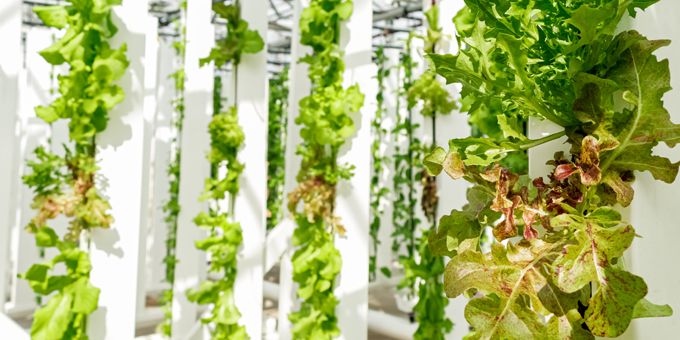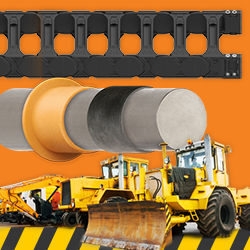We are providing a vertical growing platform that can be scaled and fills a need in the market for a growing platform that is flexible enough to cater to both home and hobby growing and large-scale commercial farming.
 Indoor Farming with Towers
Indoor Farming with Towers

Q&A with Taylor Vignaroli | ZipGrow
Tell us about ZipGrow and your role with the company.
It is important to know what we do here at ZipGrow, so let me start there. ZipGrow is an industry leader in vertical hydroponic growing systems. The world is currently experiencing many problems with food production, food security, and resource management. As the world population grows, we not only require more food, but our arable land has been on the decline and will only continue to do so. ZipGrow is tackling these problems by producing vertical hydroponic equipment for a range of markets to allow for a more centralized food system to help alleviate some of the problems we are now and will continue experiencing. The end goal is to re-centralize the food system where year-round produce that is nutritious, delicious, sustainable, and commercially profitable is available in every community globally.

As for my specific role within that, like many of us here at ZipGrow, I wear many proverbial hats. I lead our marketing efforts but more often than not I take on the role of educator. When I say “educator” I mostly mean that my number one goal is to highlight the importance of local food with the hopes that individuals understand that taking part in local food in some way—whether that be as a consumer, eductor, or grower—is to take part in a better future for themselves, their communities, our shared food system, and the environment. This is really the by-product of spending years thinking about, trying to understand, and determining the best ways to solve the global food challenges with some of the brightest minds in the world. As a result, I’ve come to understand how impactful indoor farming is as a source for local food and I’m hoping to share what I’ve learned and continue to learn.
What need in the market is ZipGrow filling?
Sustainable food production is one of the big challenges facing the world today, and it will only become a larger focus in the future. To address this problem, we need to consider innovative ways to produce food. We need a food system that actually makes sense, not what we currently have which is fractured and inefficient on nearly every level.
ZipGrow is part of the solution. ZipGrow is one of the only producers of true vertical hydroponic equipment. We are championing a proven way to grow food that is not only sustainable but is also commercially viable. We are satisfying the need for a changed, more thoughtful food system by implementing one of the potentially many solutions to a better system.
We are providing a vertical growing platform that can be scaled and fills a need in the market for a growing platform that is flexible enough to cater to both home and hobby growing and large-scale commercial farming.
Editors Recommendation "Automation and Sensors in Hybrid Greenhouses"
What are the most important factors when considering indoor farming equipment?
Crop selection and profitability are the most critical factors to consider when looking into indoor farming.
Crop Selection:
As a farmer the number one priority is selling. Bottom line. Consequently, the first question, hands down, anyone should be asking when investing in indoor farming equipment is “what should I grow?”. This should be answered by conducting market research but it often goes overlooked or gets oversimplified.
With indoor farming, you have a choice which is vastly different than what you get in traditional agriculture. Where before you were limited to what you could grow by factors such as climate and soil quality. Now, farmers turn this process on its head by tailoring their growing equipment to their ideal crop selection. And that’s how it should be, your equipment shouldn’t determine what you grow, your markets should determine what you grow.
Profitability:
Profitability should be first and foremost in the list of priorities when considering indoor farming. However, research is showing that only half of modern Controlled Environmental Agriculture (CEA) farms are operating profitably. Why? The most influential components of profitability are ultimately operating expenses, something that is often overlooked when considering production and profitability rates.
Production per square foot or meter tends to be the most pitched measure of profitability. However, this needs to be considered in conjunction with the operational cost of running this equipment. Some farming equipment’s initial cost may be higher, the production capacity per area may be lower, and it may not be as flashy as other equipment out there, but the farm ends up being far more profitable than the most productive equipment available.
How does your equipment address challenges of indoor and/or vertical farming?
As we have discussed, crop selection and profitability are the main challenges indoor/vertical farms face. Here at ZipGrow, we have addressed these challenges through research, years of testing, and intentional design. To address crop selection we have chosen specific types of crops to grow optimally—leafy greens and herbs. To address profitability we have designed the functional base to all of our products—the ZipGrow Tower. The ZipGrow Towers allow any leafy green and herb production to reduce operating expenses per square foot by minimizing labor, increasing overall usability and maximizing growing potential through our intentional design. Lighting, heating, ventilation, and air conditioning (HVAC), cost of goods sold (COGS), plant, pest, and disease management, workflow optimization, and production density have all been the foundation for which the design of the ZipGrow equipment has been built upon. This, paired with the reliable design of our Towers, ensures the growing platform is as profitable as possible.
How does ZipGrow technology work in commercial settings?
Commercial operations are all about scaling power and workflow optimization. ZipGrow has optimized the growing process in our commercial farms, focusing specifically on workflow optimization so that no matter what size of business you’re running you can be efficient and effective. We’ve done this by making bulk plant movement efficient and accessible. Our indoor systems use mobile ZipRacks that transport up to 30 8-foot Towers (or 450 plants) at once in a way that can be removed from the growing environment. This results in being able to harvest, transplant, and perform maintenance tasks on some areas of the farm while the rest of your farm remains online, which is critical in maximizing output.
Are there ways for equipment like this can be used to diversify or update current production facilities or act as an auxiliary source of revenue?
Market potential should drive decision-making. However, a lot of markets are or could be receptive to many crops. That is why it is highly likely that most farmers/operations could benefit from diversifying their crop production. We see that many successful farmers have several growing platforms that are designed to grow specific crops extremely efficiently (i.e. leafy greens and herbs or vining crops) which serve to diversify the business and bring in several lines of income to the business. We’ve seen great success in this model and encourage people to consider this for their business. Current growing operations, especially greenhouses, are prime candidates for easily adding to their existing infrastructure and increasing their profitability. If someone already has a successful business it doesn’t mean they are immune to downturns in economies or even that they are as profitable as they could be. Our equipment paired with others and other equipment paired with ours is a great way to diversify and promote auxiliary sources of revenue.
What role does automation play in your systems?
Automation plays a key role in our systems, namely our commercial systems. In its most basic form, automation should improve an operation’s profitability. This can take form in many ways; process simplification, process elimination, process shortening, data collection, and data analysis. Some aspects of the growing process are far too expensive to automate, such as transplanting, which is why we’ve been careful to choose technology that allows our farmers to automate the most cost-effective portions of the growing process, like automatic dosing and timers. These are simple, relatively inexpensive, and highly effective ways that automation can make a farm profitable. There are, however, other forms of automation that currently aren’t cost-effective on the smaller end of the commercial spectrum just yet, such as harvesting and data collection. While we haven’t found a cost-effective solution for these types of automation, these are all aspects that ZipGrow is exploring and will continue to explore in the future.
Look into the future several years, where do you see the indoor farming market and how do you see ZipGrow playing a part in these advancements?
Indoor farming is rooted deeply in the pursuit of efficiency. Efficiency will continue being a focal point in the Controlled Environment Agriculture sector. With equipment and electronics becoming more cost-effective, we will only see more technology and automation being incorporated in the already technology-heavy farms. Sensors and data collection have made understanding every aspect of our farms more efficient than we could ever make them with raw man-power. The mass accumulation of farm data will bring about a level of understanding that would be impossible otherwise.
Alongside this, the CEA market is currently divided up into small, privately funded farms and large, venture capital-funded commercial operations. Neither of which have become widely known or accepted as a legitimate path forward to creating a smarter food system and source of economically viable food. Though the large venture-backed operations are getting close, they haven’t “cracked the code” yet in terms of profitability. This will be the first significant change in the market, large-scale indoor farming will have become profitable and pave a path forward for highlighting the legitimacy of the technology for other smaller markets. While small-scale commercial indoor farming has been proven effective, it hasn’t been 100 percent foolproof. The second change I foresee happening in the not-so-distant future is that these smaller operations will become extremely effective and nearly ubiquitous as they are integrated into most communities. ZipGrow will continue being an industry leader in not only providing the current industry with expert advice and products but will also be a front runner in ongoing research and development to expand vertical hydroponic growing throughout the world.
If you like this article you may like "Automated Commercial Containers for Cannabis Cultivation"
The content & opinions in this article are the author’s and do not necessarily represent the views of AgriTechTomorrow
Comments (0)
This post does not have any comments. Be the first to leave a comment below.
Featured Product

